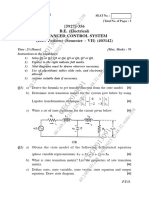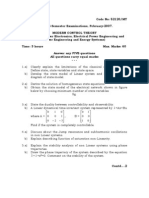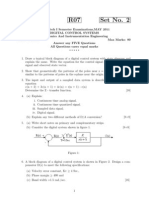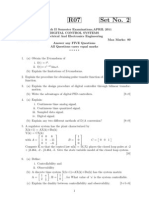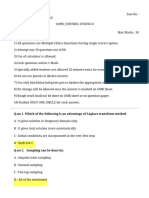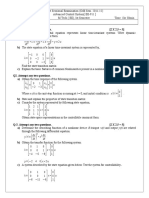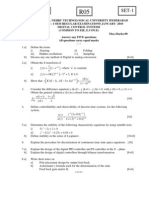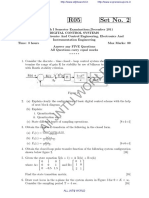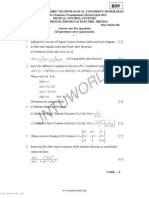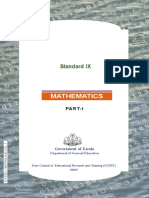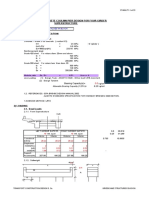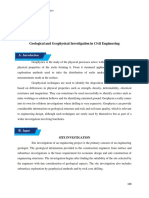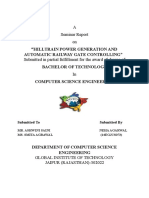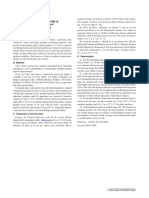Total No. of Questions : 8] SEAT No.
8
23
P568 [Total No. of Pages : 2
ic-
[6004]-504
tat
B.E. (Electrical)
6s
ADVANCED CONTROL SYSTEM
3:3
(2019 Pattern) (Semester - VII) (403142)
02 91
4:3
Time : 2½ Hours] [Max. Marks : 70
0
31
2/0 13
Instructions to the candidates:
0
1) Attempt Q.1 or Q.2, Q.3 or Q.4, Q.5 or Q.6 and Q.7 or Q.8.
6/2
.23 GP
2) Figures to the right indicate full marks.
E
82
8
Ys S1
C
23
Q1) a) 2
U s S 1.3S 0.4 Given system represent in [10]
ic-
16
tat
8.2
6s
i) Controllable canonical form.
.24
3:3
ii) Observable canonical form.
91
49
4:3
30
31
0 1
b) For a given system A , x(0) = [1 0]T.
01
02
3 4
6/2
GP
Obtain STM & find its solution.
2/0
[8]
CE
82
8
OR
23
.23
Q2) a) Explain and derive the Cayley Hamilton theorem of STM.
ic-
[8]
16
tat
b) Derive the transfer function from the state variable model and Evaluate
8.2
6s
Ys
.24
3:3
91
the transfer function from the state variable model of a discrete
Us
49
4:3
30
31
time system with usual notation. [10]
01
02
1.8 1 1
6/2
GP
X x u
2/0
0 2.5 0.5
CE
82
Y 1 0 x
.23
16
8.2
.24
P.T.O.
49
� 0.1 0.1 0 1
8
23
Q3) a) Given X 0.3 0.1 0.2 x 1 u & Y 1 0 1 x .
ic-
0 0 0.3 0
tat
6s
Determine controllability & Observability of the system. [8]
3:3
b) Derive and explain Ackermann’s formula for Pole placement design. [9]
02 91
4:3
OR
0
Q4) a) What is principle of duality? Explain the effect of pole-zero cancellation
31
2/0 13
on controllability & Observability. [8]
0
6/2
.23 GP
0 15 0
b) For a given system A 1 0 , B 1 , C 0 2 .
E
82
8
Determine observing gain matrix Ke such that S1, S2 = –2 + j3 are eigen
C
23
values of observer gain matrix.
ic-
[9]
16
tat
8.2
6s
Q5) a) Explain in detail basic building blocks of discrete time control system.
.24
3:3
[8]
91
49
4:3
b) Explain the sampling & reconstruction process, State the sampling theorem
30
31
and Give its importance. [9]
01
OR
02
6/2
Q6) a) Show how mapping of left half of S-plane is done into the Z plane with
GP
stable and unstable Region.
2/0
[8]
CE
b) Determine stability of system using Jury’s Test whose characteristic
82
8
23
polynomial is 2z4 + 8z3 + 12z2 + 5z + 1 = 0. [9]
.23
ic-
16
tat
Q7) a) Define adaptive control. Explain the need of adaptive control. What is
8.2
6s
adaption mechanism? [6]
.24
3:3
b) Explain Gain scheduling adaptive control strategy with proper block
91
49
4:3
diagram. [6]
30
31
c) Draw block diagram of Model Reference Adaptive Control scheme and
explain it.
01
02
[6]
OR
6/2
GP
Q8) a) Describe a self-tuning regulator with suitable block-diagram. [6]
2/0
b) List out the properties of sliding mode control. [6]
CE
82
c) Explain the terms, variable structure control, sliding mode control, sliding
.23
phase, reaching phase and chattering with suitable diagram. [6]
16
8.2
.24
49
[6004]-504 2

